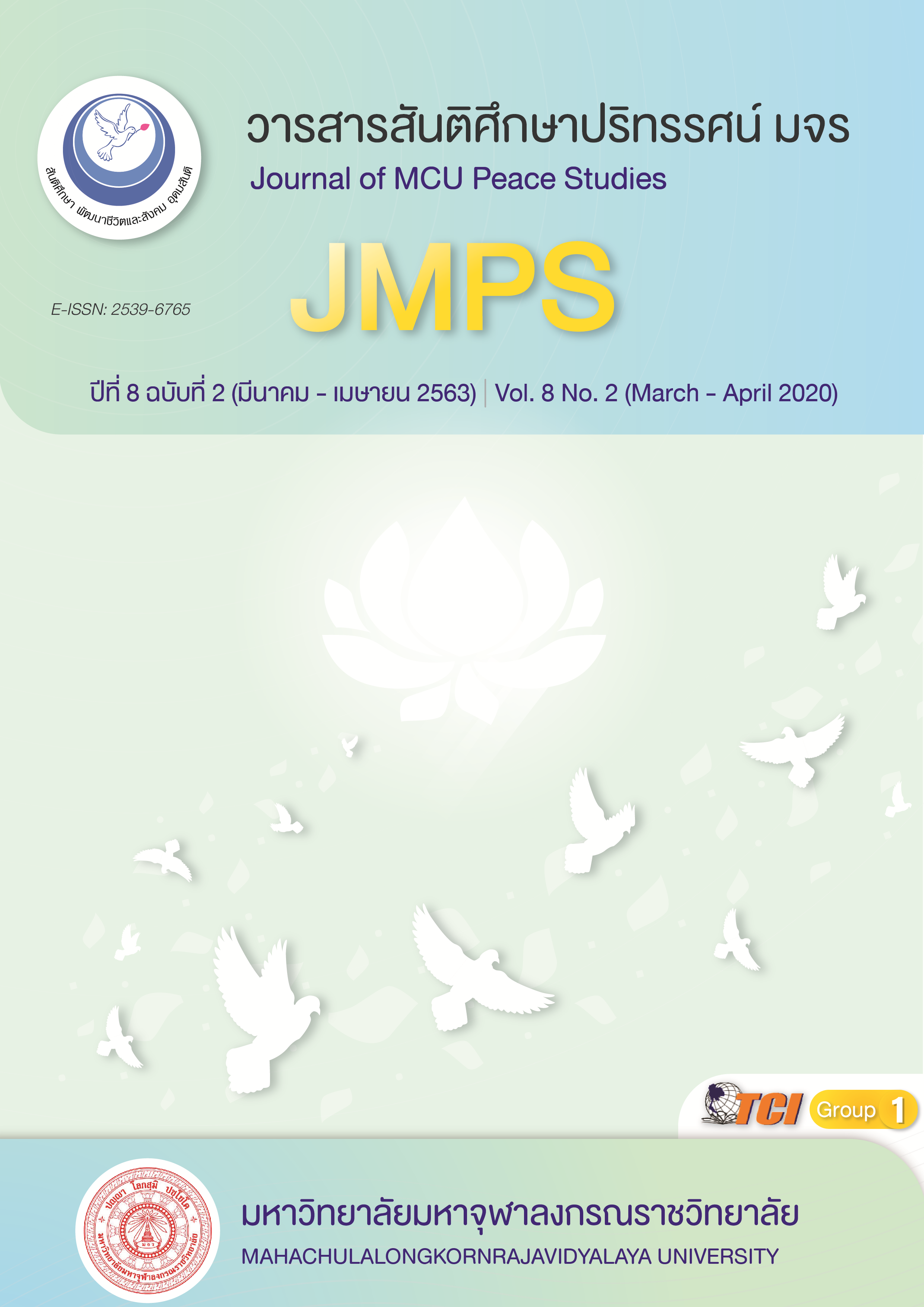ปัจจัยคัดสรรที่สัมพันธ์กับสุขภาวะทางจิตของผู้สูงวัยในบริบทพุทธจิตวิทยา
Main Article Content
บทคัดย่อ
งานวิจัยนี้มีวัตถุประสงค์ 1) เพื่อศึกษาสุขภาวะทางจิตของผู้สูงวัย 2) เพื่อศึกษาปัจจัยคัดสรรที่มีความสัมพันธ์เชิงทำนายกับสุขภาวะทางจิตของผู้สูงวัยในบริบทพุทธจิตวิทยา รูปแบบการวิจัยเป็นการวิจัยเชิงปริมาณ ใช้แนวคิดสุขภาวะเชิงอัตวิสัยของ Ed Diener มาเป็นกรอบการวิจัย เก็บข้อมูลในพื้นที่อำเภอเดิมบางนางบวช อำเภอบางปลาม้าและอำเภออู่ทองจังหวัดสุพรรณบุรี กลุ่มตัวอย่าง คือ ผู้สูงวัยที่มีอายุระหว่าง 60-79 ปี จำนวน 302 คน ใช้วิธีคัดเลือกตัวอย่างแบบสมัครใจ เครื่องมือที่ใช้ในการวิจัยเป็นแบบสอบถาม จำนวน 5 ฉบับ ได้แก่ 1) แบบวัดสุขภาวะทางจิต 2) แบบวัดอารมณ์เชิงบวก 3) แบบวัดหลักธรรมพรหมวิหาร 4) แบบวัดหลักธรรมสังคหวัตถุ และ 5) แบบวัดหลักธรรมไตรลักษณ์ วิเคราะห์ข้อมูลด้วยสถิติ ค่าเฉลี่ย ส่วนเบี่ยงเบนมาตรฐาน และการวิเคราะห์การถดถอยพหุคูณ ผลการวิจัยพบว่า
- ผู้สูงวัยในจังหวัดสุพรรณบุรีมีคะแนนเฉลี่ยสุขภาวะทางจิตค่อนข้างสูง (= 22.95, S.D.= 1.76)
- 2. ปัจจัยอารมณ์เชิงบวก เมตตา อุเบกขา ปิยวาจา อัตถจริยา และอนัตตา มีความสัมพันธ์กับสุขภาวะทางจิต และร่วมกันทำนายความแปรปรวนของสุขภาวะทางจิตได้ร้อยละ 57.20
ข้อค้นพบจากงานวิจัยครั้งนี้คือ ปัจจัยคัดสรร 6 ปัจจัย ได้แก่ อารมณ์เชิงบวก เมตตา อุเบกขา ปิยวาจา อัตถจริยา และอนัตตามีความสัมพันธ์เชิงทำนายกับสุขภาวะทางจิตของผู้สูงวัย โดยที่ปัจจัยเมตตามีอิทธิพลสูงสุด รองลงมาคือ อารมณ์เชิงบวก ดังนั้นแนวทางการเสริมสร้างสุขภาวะทางจิตในผู้สูงวัยควรเน้นกิจกรรมที่ทำให้เกิดปัจจัยดังกล่าว โดยเฉพาะอย่างยิ่งการเจริญสติและเมตตาภาวนาอย่างสม่ำเสมอและต่อเนื่อง
Article Details
ทัศนะและความคิดเห็นที่ปรากฏในบทความในวารสาร ถือเป็นความรับผิดชอบของผู้เขียนบทความนั้น และไม่ถือเป็นทัศนะและความรับผิดชอบของกองบรรณาธิการ ยินยอมว่าบทความเป็นลิขสิทธิ์ของวารสาร
เอกสารอ้างอิง
Attasaranya, P. (2012). Study of Relationships among Self-Esteem, Self-Compassion, Body Mass Index, Self-Objectification, and Body Image Satisfaction in Female Adolescents. (Master's Thesis). Chulalongkorn University. Bangkok.
Basson, M.J., & Rothmann, S. (2018). Flourishing: Positive Emotion Regulation Strategies of Pharmacy Students. International Journal Pharmacy Practice, 26(5), 458-464.
Cohen, S., & Pressman, S.D. (2006). Positive Affect and Health. Current Directions in Psychological Science, 15(3), 122-125.
Cohen, J. (1988). Statistical Power Analysis for the Behavioral Sciences. (2nd ed.). New Jersey: Lawrence Erlbaum Associates.
Chotitada, K. (2015). A Practice of Sangahavatthu and Coordinating Operation of Bureau of Printing, the Secretariat of the House of Representatives. (Master's Thesis). Mahachulalongkornlajavidyalaya University. Ayutthaya.
Diener, E. (1984). Subjective well-being. Psychological Bullentine, 93, 542-575.
Diener, E., & Diener, C. (1996). Most people are happy. Psychological Science, 7, 181-185.
Foundation of Thai Gerontology Research and Development Institute (TGRI). (2016). Situation of the Thai elderly. Bangkok: Author.
Hair, J.F., Black, W.C., Babin, B.J., Anderson, R.E., & Tatham, R.L. (2014). Multivariate Data Analysis. (7th ed.). New Jersey: Pearson Prentice-Hall.
Hofmann,S.G. et al. (2015). Loving-Kindness Meditation To Target Affect In Mood Disorders: A Proof-Of-Concept Study. Evidence-Based Complementary and Alternative Medicine, 34(4), 277-289.
Karnkha, O., & Thaithani, P. (2014). The Effects of Positive Self-Talk Training Program on Emotional Intelligence of the First Year Students of Nakhon Ratchasima Rajabhat University. Ratchaphruek Journal, 12(2), 61-69.
Monsintorn, J., & Mukdee, S. (2018). A Mental Development Model of University Students According To Three Characteristics (Tilakkhana). Journal of Graduate Study Review, 13(Sup1), 171-184.
Office of the National Economic and Social Development Board. (2013). Population Projections for Thailand 2010-2040. Bangkok: Author.
Philip, B.H., & Tierney, B. (2009). Religion and Subjective Well-Being among Elderly in China. International Journal of Science and Research, 38, 310-319.
Phra Brahmagunabhorn (P.A. Payutto). (1997). Manual Life. (14th ed.). Bankok: Pimsuay.
Phra Brahmagunabhorn (P.A. Payutto). (2002). Dictionary of Buddhism. (11th ed). Bankok: SR Printing.
Seligman, M. (2000). Positive psychology: An introduction. American Psychologist Journal, 55(1), 5-14.
Seligman, M. (2011). Flourish: A Visionary New Understanding of Happiness and Well-Being. New York: Atria Books.
Somdet Phra Buddhaghosacariya (P.A. Payutto). (2016). Buddhadhamma. (19th ed.). Bangkok: Phlidhamma.
Sangkhaha, P., Phakruwiratthammachot, & Nutnongkeaw, K. (2018). AnApplication of Existence in Social Adaptation of The Elders in NakonHad YaiMunicipality, Had Yai District, Songkhla. Nagkbhut Pariat Journal, 9(1), 203-211.
Wichitsiri, P., & Sawangsopakun, B. (2012). Wisdom, Social Support and Psychological WellBeing of Elderly in the Elderly Club at Wat Sarod Rat Burana district, Bangkok. Journal of Humanities & Social Sciences, 38, 139-151.
Wongsombut, W., & Hatthasak, M. (2017). The Effects of Sungkhahawatthu 4 to develop public mind for second year undergrad students Faculty of Education Kasetsart University. Journal of MCU Peace Studies, 5(1), 238-251.
World Health Organization. (2001). Constitution of WHO: Principles. Retrieved October 24, 2018, from: https://www.who.int/about/mission/en.


